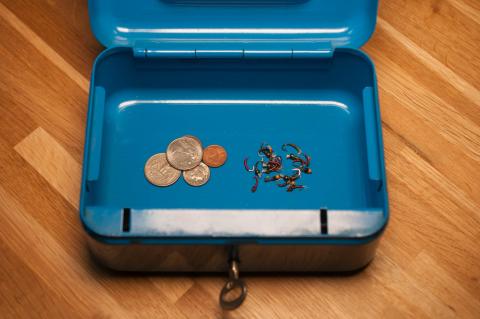Recent comments
Nycflyangler,
Some of the really crazy mouse patterns incorporating foam and deer hair aren't that far off!
Martin
- Log in to post comments
Martin,
Regarding the weighted flies. Have you thought of using a loop of heavy test monofilament instead of rabbit? That would also work as a weed guard as well. Mono is certainly cheaper than rabbit fur.
- Log in to post comments
One of the advantages of a tube fly is that it can slide on the leader away from the fish so that teeth do not damage the dressing, thereby increasing the longevity of the fly. Should only one end slide using this system the fly will be lost.
- Log in to post comments
Hi, Andrea.
Welcome. I'm looking forward to those stories.
How about some photos?
My Grandmother was from Lucca which I see is only 2 hours
or so from you.
Nice to meet you.
PoppyT
- Log in to post comments
I just tried using this setup by taking a tube fly that was built on a medium size tube. I used a micro tube as directed by the setup instructions in this article. One thing you forgot to mention is that you must also melt a collar on the side of the insert tube that fits into the tube fly so that it is tight and will not fall out. The insert tubes must be snug inside the tube fly or you will lose your tube fly. There is nothing to hold the insert inside the tube fly. In addition, the insert cannot be too snug or tight because that would defeat the purpose by not being able to get the inserts out quickly to change flies. I think you are going to have a problem switching from different size tube flies, i.e.: large diameter tubes or medium diameter tubes unless you only build on one size tube. If the insert becomes lose, you can kiss your tube fly goodbye. In theory it sounds wonderful. In use is another story. Good luck with this. I will stick to running the tippet through the tube fly and not worry about losing my flies.
- Log in to post comments
Ummm, not knowing better when I started using a tube fly; I tied a long loop at the end of the leader, sent the loop through the tube and then through the eye of the hook as a 'loop to loop' or square knot. Save the loop when doing a fly change.....
- Log in to post comments
This is a great idea. Unfortunately it won't work if your building your flies on micro tubes to begin with. You're basically building your flies on medium or large tubes and sliding the micro tube inside as an insert. The basic idea is worthwhile and definitely has it's place in tube fly tying. Good job!
- Log in to post comments
Richard and Martin,
Thank you very much for answering my question. I have been tying for a while now, but I mostly fish salt water for striped bass around Massachusetts in the States, so my use of feathers tends to be a little less delicate. I trout fish when the opportunity presents itself, but there's far more salt water around me than there is fresh. I have been tying small dry flies and streamers for a couple of years and outside of hackle, haven't used many skins. I'm constantly fascinated, and somewhat overwhelmed by how much deeper into the weeds you can get with this hobby (obsession?), and I really appreciate the help. Thanks for the article and all the great work you guys do.
Andrew
- Log in to post comments
I would like to print out step by step instrutions of cinnamon brown emerger by dave mcphail cant find
it on any web sites can you help thank for your help ed
all I find is videos
- Log in to post comments
This pattern is a fish getter. trust me it works very well for me...
- Log in to post comments
Loretta, Marc would be so proud of you. You outdid yourself on this collection. Bravo!
- Log in to post comments
Awesome streamer conversions of tried and true salmon patterns. I may have to tie a few of these for the opener! The Miramichi still has plenty of ice, and once she opens, big streamers like these should be perfect for getting down to where the kelts are!
I don't mean to be picky, but "Nashwack" should be spelled "Nashwaak"
- Log in to post comments
Stunning collection Loretta,well done....
- Log in to post comments
I would like to say here,thankyou for sharing your streamers with us,a job well done. Like all of the patrerns presented and as far as this goes it is really a beaut. Great commeration. Thankyou,
- Log in to post comments
Those guides are absolutely terrible. Literally had to stop watching I was getting so mad. Stop barking commands and net the fish for Christ's sake!
- Log in to post comments
If anyone is interested in seeing how these feathers are used on flies, search "You Tube" for: Richard Katzman, Catskill Tube Flies and Catskill Hook Flies. I use a lot of these feathers for my flies. With 8 skins I have an enormous amount of feathers to chose from. These feathers will supply me with many years of fly tying material and an enormous amount of tube and hook flies. The cost of preserving the skins and the time involved is a small investment for the amount of material you get.
Best regards,
Richard
- Log in to post comments
Phil, thank you for asking that question. The easiest way to answer your question is, very liberally. You need to cover the skins totally in various stages of preservation. As far as the baths are concerned, I bathed them in a utility sink with enough water, soap and white vinegar to get a very soapy solution to cover the 8 skins.
The full amounts of items that I bought are:
Kitty Litter; 20 lbs largest box
White Vinegar: half gallon
Dawn Soap: 9 Oz
Boric Acid: 20 lbs
Baking Soda: 5 lbs
Too much of the above is not too much. The more you use the better the skins will do. Remember these skins are oily and some are fatty. I don't know how many skins you will be preserving which will dictate how much material you will need to use. The rule if thumb I used was, if the skins smelled, I repeated the procedure. The White Vinegar does a great job mixed with the other items. Good luck with preserving your feathers. If you need any other advice, you can email me.
Richard
- Log in to post comments
You neglected to say what the proportions of soap, vinegar, borax and baking soda were. Phil
- Log in to post comments
Pit,
There's a whole article on handling chickens and preserving their skins here. Once you have the skin, you can use Richard's method as described here or the one I describe using salt and pinning the skin to a board.
Martin
- Log in to post comments
thanks a lot for this article. I am just going to keep chickens in my garden to have eggs, meat and feathers. is it the same way with chickens and other poultry? like pheasant, black bird, magpie or partridge.
pit
- Log in to post comments

